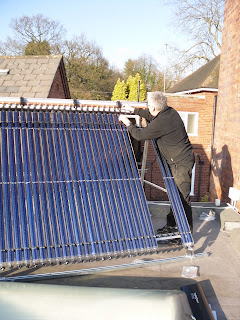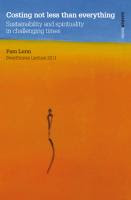In this picture, you can just see the panels on the roof above the dining room, to the left of the chimney. Because Woodbrooke is a Grade II listed building, there are restrictions on what we can do. Most importantly, the panels had to be invisible from the main elevation viewpoint.
The panels have been installed to supply the kitchen and 11 bedrooms. The solar-warmed water feeds into the gas-fired condensing boiler that serves that part of the building, resulting in the boiler starting with pre-warmed water, and thus using less gas to raise the water to the required temperature. The kitchen uses large amounts of hot water during the daytime, when the the sun is producing most heat, and this makes the most efficient use of the hot water produced by the panels, as there's little or no loss by cooling while the water sits there not being used. Solar thermal is highly effective - I posted here in early December about my domestic installation: I haven't used any supplementary water heating since the 2nd week in March (though it's snowing again today, so that might not last just yet until the weather improves!).
The technology we have at Woodbrooke is evacuated tubes, which are fitted onto a rack constructed on the flat roof - this allows the angle and direction of the tubes to be set at the optimum for solar collection, whereas on a pitched roof, the collectors are at the direction and angle of the roof, whatever that is. So, at home, I have to have my panels facing east and west, whereas at Woodbrooke they are set at due south.

Think of the tubes as long thin vacuum flasks! The solar radiation crosses the vacuum, but the inner part of the tube is protected somewhat from the cooling effects of wind, rain and cold weather.
The inner parts of the tubes are filled with a fluid with high 'specific heat' (ie: fluid that can hold a lot of heat, chemically similar to the antifreeze that goes in car radiators). The fluid from all the tubes is pumped through an insulated pipe that takes it to the boiler. There, the pipe (minus insulation!) is surrounded by the incoming cold water feed, and gives up its heat to the water. The now cooled fluid is pumped back to the roof in a continuous flow, where it is heated again by the sun.

Because Woodbrooke is an educational establishment, and the is building used by many people, it's good if we can do some additional education by the presence of the solar system.
To that end, we have an impressive-sized display unit in the long corridor, which most people will walk past several times a day. It gives a schematic representation of how the system is working, and displays the current temperatures minute by minute.
So you can see in this picture that the temperature up at the top of the panels (the warmest part) was 41.7 degC (this was in mid-March). The temperature to which the incoming cold water feed (at the boiler) had been raised was 25.5 degC.
The last figure, at the bottom of the panel, is interesting. This electronic display system measures the temperatures continuously, calculates the energy saved by the fact that the gas is working on pre-warmed water, converts that saved energy figure into equivalent kWh (kilowatt-hours), and displays the result. This is a cumulative result - it just keeps on adding it up. This photo was taken very soon after installation, when it was only up to 40 kWh. Today, as I'm writing (31 March - just a couple of weeks later) it's up to 297 kWh (that's the total energy saved so far); and that's during a spell of mostly miserable weather! As we get further into the year, with more hours of sunlight, and the sun higher in the sky, this figure will build up much more quickly. The highest I've seen the top temperature reading so far was 58 degC on a bright, but chilly sunny morning.
At the moment, the government is about to provide incentive for solar electricity installation via the imminent feed-in tariffs, but as yet there is no scheme for other forms of renewable energy. However, there is a published consultation document, Consultation on the Renewable Heat Incentive (RHI) which hopefully will lead to similar schemes for other technologies some time next year - and solar hot water is explicitly part of this consultation. Some energy suppliers working solely with renewables, such as Good Energy, already have such a scheme in place for their customers, although at a fairly low level; for instance Good Energy's HotROCs scheme which currently applies to solar hot water.
The Low Carbon Buildings Programme (LCBP) has a special section for public and voluntary sector organisations. The grants for solar electricity have been stopped now (as is the case for domestic installations) because the feed-in tariff replaces the block grant as the financial incentive. But there are still grants for other technologies, including solar hot water. The system here at Woodbrooke cost just under £15K to install - plus VAT at 5% (because we're a charity). The grant from the LCBP was half of the pre-VAT figure, just under £7.5K. We also received an extremely generous donation towards the work from a Birmingham Friend who has a long association with Woodbrooke, and was keenly interested in energy efficiency and renewable technologies long before it was a fashionable topic! The carbon offsetting donations also contributed - so those offsets will now be saving energy for years to come. Please keep the offsets coming - they'll go towards out next project (probably photovoltaics . . . we'd need 66 panels!).
* * * * *
Thanks to Louise Vizor (Marketing and Fundraising Assistant) for the photographs.* * * * *
I'm taking next week off, for Easter, so this post will stay at the top for two weeks - see you again around 13th/14th April.* * * * *
If you want to post a comment and are having technical difficulties, you can email your comment to me at Good.Lives@woodbrooke.org.uk, and I can post it for you.
.jpg)










































